11 Antique Tin Toys That Command Big Money Today
Antique tin toys have become much more than just childhood playthings. They are now highly sought-after collectibles. Over the years, these toys have gained incredible value due to their craftsmanship, age, and rarity. What makes these toys so appealing to collectors is the nostalgic connection to a bygone era. Their unique designs and limited production runs add to their allure, often leading to surprising prices at auctions. If you’re into rare finds, these antique tin toys offer a fascinating glimpse into the past.
This post may contain affiliate links, which helps keep this content free. Please read our disclosure for more info.
1910s Marklin Live Steam Fire Truck
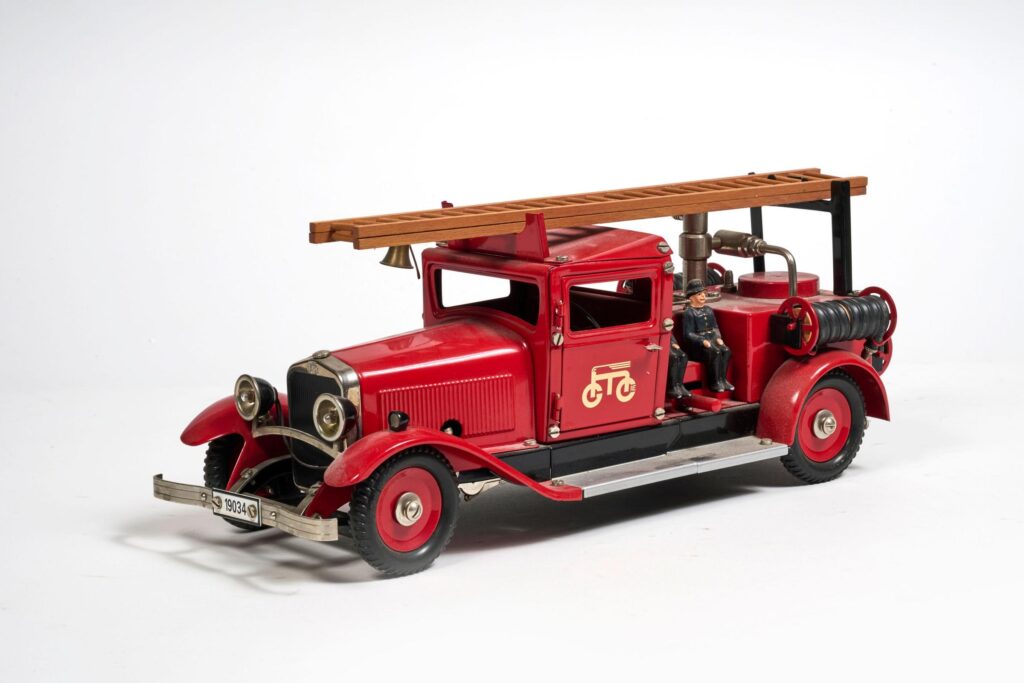
Produced by the German firm Marklin sometime in the early 1900s, this live steam fire truck was reportedly about 16 inches long, with a brass boiler and tin-plate body. When offered at auction it carried an estimate of around $1,200-$1,500 and realised around $12,650. Its value lies in the live steam boiler mechanism combined with tinplate body work which is rare for toys. The maker’s reputation for quality and the relative scarcity of examples in good order play a big role. For those who collect mechanical tin toys this truck is a standout.
In addition the toy is one of very few of its type to have both the working mechanism and original paint lithography. The condition of the boiler, lack of rust, and minimal modification help keep interest high. Because many tin toys of that era were played with hard or damaged, surviving good examples are prized. This truck reveals how advanced toys were in that period. It serves as a benchmark for serious toy-collectors looking at metal mechanical pieces.
1910 Tin Toy Limousine by Georges Carette
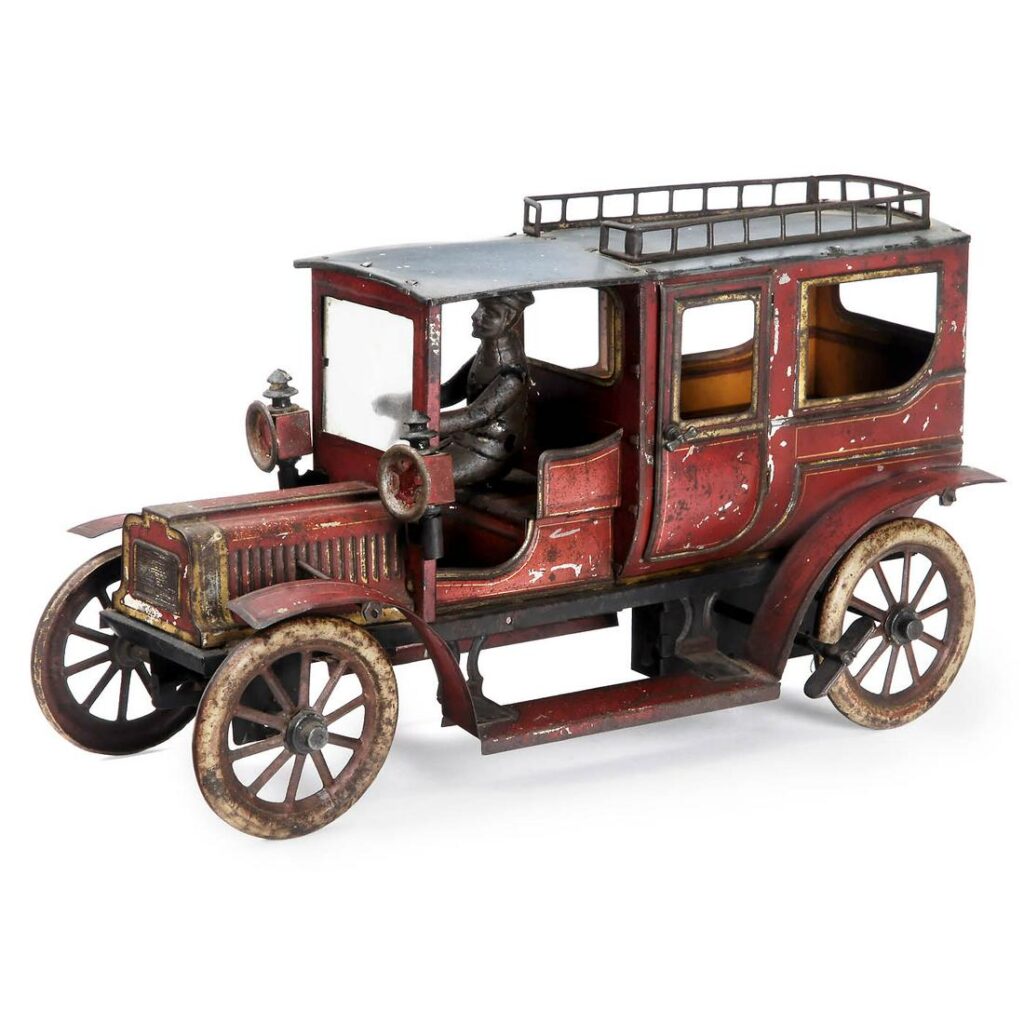
This tin plate limousine, attributed to Georges Carette around 1910 in Germany, is characterised by its side-lanterns, opening doors and seated chauffeur figure. In recent sale listings it commanded several tens of thousands of dollars, though exact original retail value is unclear. What drives its value is the high level of detail, original condition, and the fact that it comes from one of the top tin-toy makers of the era. Collectors view this model as a rare example of luxury toy vehicles from the tinplate period. Its survival with minimal restoration helps its worth.
Further interest arises because the work shows lithographed tin detail rather than simpler painted forms, making it visually striking. Details like the chauffeur figure and lanterns set it apart from generic cars of the era. It also helps to illustrate how tin toy makers catered to wealthier buyers, with toys that mirrored real luxury cars of the time. For someone exploring early automotive tin-toys this limousine is a key piece.
1904 Gunthermann Open Phaeton Clockwork Auto
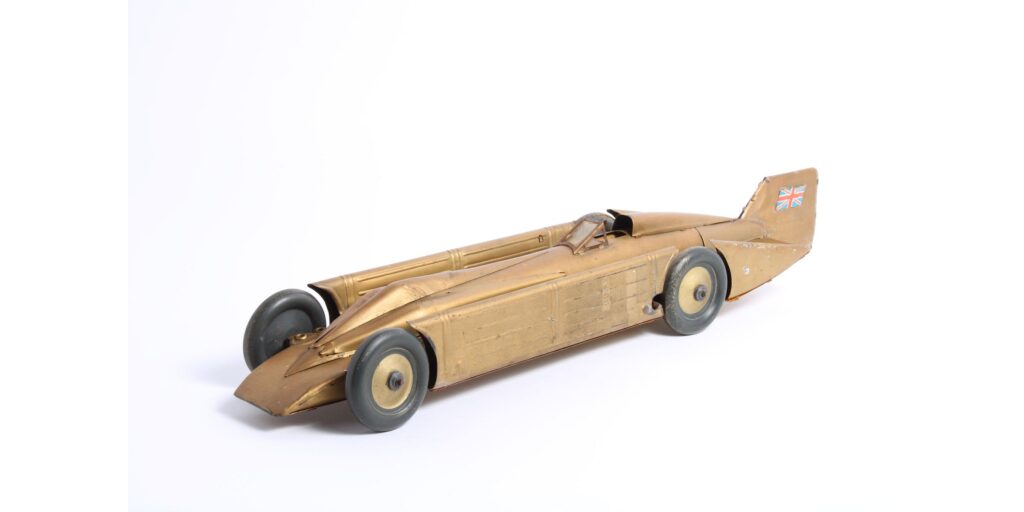
Made by German maker Gunthermann around 1904, this clockwork open-phaeton auto was once estimated around $15,000-20,000 and sold for around $36,800 in a major collection auction. It features detailed elements such as spare tire on bonnet, chain drive visible and clockwork motor under hood. Its rarity arises because few survive in this level of preservation and with original components. This auto draws attention because it replicates real car mechanics at toy scale and comes from an early era of tin toys. It is coveted by those who focus on automotive tin toys.
This model stood out for its period accuracy, original clockwork mechanism, and large size relative to other toys of the time. The fact that it came from a major toy collection raised its profile among serious buyers. Its good condition and intact mechanism add to its value. For a collector wanting a mechanical tin auto with historic significance this piece checks several boxes. It helps demonstrate how tin toys can reflect real world vehicles and engineering trends.
1910-12 Bing Taxi Clockwork Open Roadster
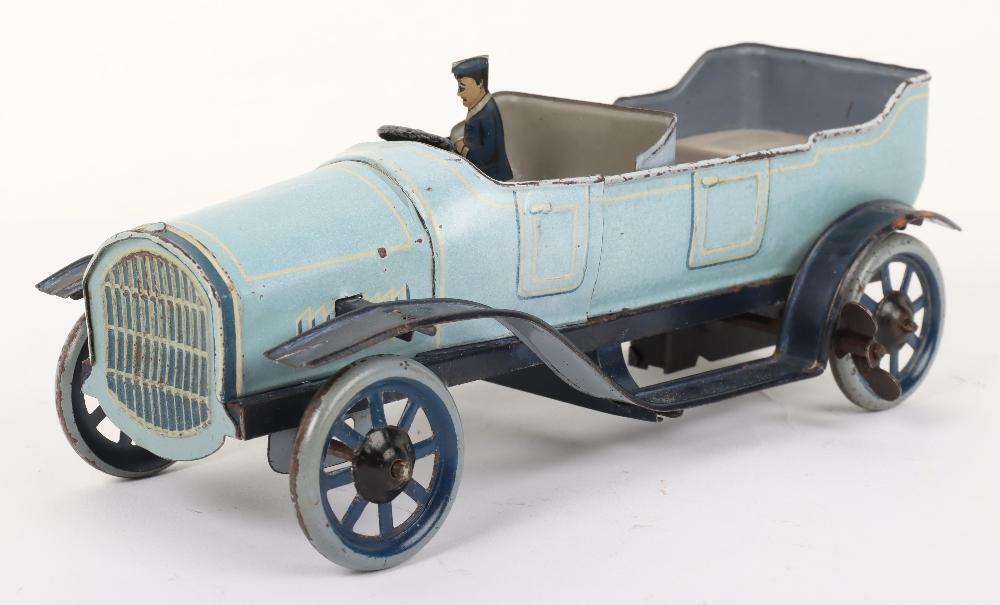
This tin-plate clockwork taxi by the company Bing (Germany, circa 1910) featured open roadster styling and is often estimated in auction catalogues at around $18,000-20,000, with actual sale at about $46,000. The reasons for its high value include the maker, the condition, the intact clockwork movement and original finish. It is one of the better known toy vehicles from the tin that mimicked early 20th century taxis. Because many similar items were heavily used or restored, surviving examples in good condition are rare. For those interested in urban vehicle tin-toys this one is a preferred example.
Beyond the mechanics and condition, the taxi has visual appeal, nice lithography, and original driver figure, making it feel more like a model than a simple toy. Its story helps collectors to see how toys reflected practical vehicles of the period. The fact that it achieved a high price in auction shows the collector market values condition, maker and originality. It provides a good case study for how tin-toy vehicle values can escalate if all elements align.
1910s Biscuit Tin Delivery Truck

Around 1910s, some manufacturers produced tin-plate delivery truck toys (e.g., biscuit delivery trucks) that are now rare. One example from a major collection was estimated at $8,000-9,000 and realised about $23,000. The high value comes from the relatively small number of surviving units, the vivid lithography, original moving parts and the period representation of delivery vehicles. This kind of toy appeals to a range of collectors: tin-toy-specialists, vehicle collectors and early 20th-century toy historians. Its example helps illustrate that not just luxury cars but everyday toy vehicles can command high prices.
What helps this model’s value is its visual charm-bright graphics, functioning wheels and drivers-and the fact that it embodies commercial transportation of the early 1900s. Good condition and original paint make it stand out. For someone focusing on tin trucks, this piece will likely feature in reference lists. Its success in auction shows how even workaday toy vehicles can become desirable if survival is good.
1910s Lehmann Quex Motorcycle and Rider

This tin-plate wind-up motorcycle and rider, made by the German firm Lehmann around the 1910s, is considered one of the rarer models in the Lehmann lineup. One auction result showed it realised around $27,600, compared to an estimate of about $7,000-9,000. The rarity comes from its clockwork mechanism, intact original rider figure, and the small production numbers of this particular model. It appeals strongly to tin toy collectors who favour wind-up vehicles and detailed construction. Because of the niche nature of tin motorcycles, this piece is a highlight for those in that sub-category.
Beyond that, the fact that it is from a well-known German maker who produced many quality toys contributes to its desirability. Original condition, working mechanism and minimal rust are important factors. The model helps show how tin toy makers applied the wind-up mechanism to all kinds of vehicles, not just cars. For a collection to be strong in wind-up vehicles this motorcycle is a key inclusion.
1905 Hubley Giraffe Royal Circus Wagon
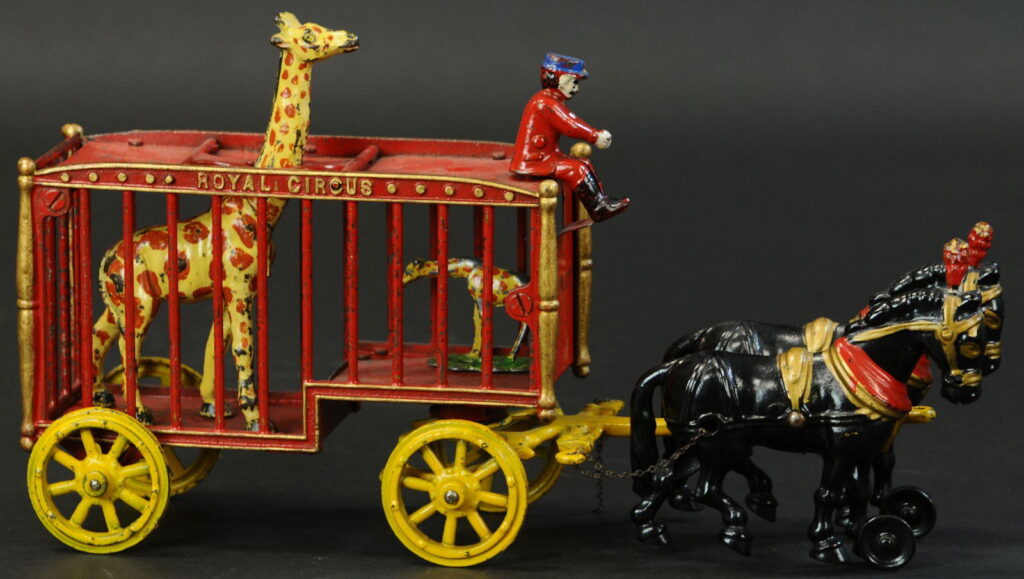
Made by the American company Hubley around 1905, this tin circus wagon featuring giraffes was estimated at $7,000-9,000 and sold for about $19,550 in a major auction. Its value rests on its circus theme, detailed figure work, and rarity of surviving subjects from this era in original condition. Circus-themed tin toys tend to be particularly collectible because they invoke spectacle and early cinema-era amusement themes. This wagon offers both mechanical motion (often horses or wheels rotate) and decorative lithography. For those collecting circus tin toys or American tin plate pieces it is a standout.
What enhances the interest is that many circus wagons were played with roughly and few survived without damage, so good condition adds premium value. The fact that it carries American manufacturing from a period when German tin toys dominated also appeals to some collectors. The combination of subject (giraffe, circus) and maker makes it memorable. Its price reflects how specialty subject plus rarity can drive high valuations in tin toy collecting.
1910 Lehmann Tin Litho Wind-Up Lulu Pecking Bird
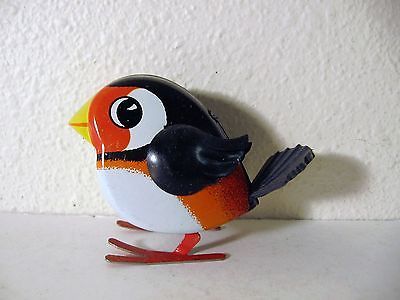
From the German maker Lehmann circa 1910, this wind-up tin lithographed toy Lulu Pecking Bird is an example of a mechanical novelty rather than a vehicle. In the market it was listed among rarities with an auction result around $14,160 compared to estimate of $7,000-9,000. Its appeal lies in its real working wind-up motion, attractive lithographed bird design and small surviving numbers in good original shape. Collectors of mechanical novelties of the tin era find this toy especially attractive. Its value shows how even non-vehicle items can achieve high status when condition and mechanics align.
The genre of wind-up tin toys with animals or novelty figures is less crowded than vehicle toys, which adds to this piece’s standing. Original key, intact body and minimal corrosion are key condition criteria. It helps illustrate the range of tin toys beyond cars and trucks. For someone building a collection of early tin mechanical novelties this is a reference piece. The fact that it realised well over its estimate underlines the strong interest in these objects.
1910 Father Christmas Penny Toy

This penny toy style tin Father Christmas figure, made around 1910, was estimated at $4,000-5,000 and sold for roughly $6,000 in auction. While the monetary figure is lower than some vehicles, its value is significant for a small tin toy figure. The rarity comes because penny toys (small, simple tin toys sold cheaply in their era) survive in fewer numbers and the Father Christmas subject is especially collectible. This piece helps show that even modest-sized tin toys can carry serious collector interest if condition and subject are right. For collectors of German penny tin toys this one is high on wish lists.
Its appeal is tied to its subject matter (Father Christmas) and early production era, lithographed tin and use as a small novelty rather than large mechanised toy. Condition including minimal rust, original key or mechanism, and intact lithography determine value. It serves as a reminder that condition, subject matter and rarity all play large roles in tin toy collecting. For collectors who want to explore beyond big vehicles this tin figure offers a different path.
1960s Bandai Tinplate Police Car
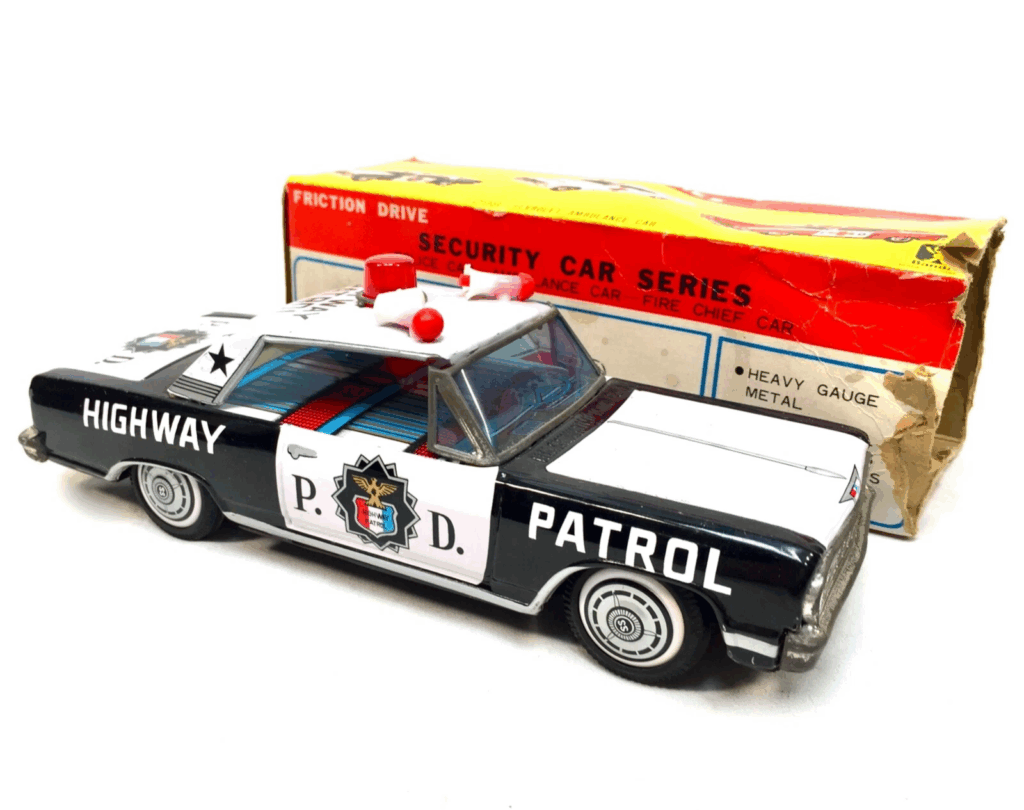
Released by the Japanese company Bandai in the 1960s, this tinplate police car was part of a larger set of wind-up vehicles. While initially sold for under a few dollars, it now commands around $1,500 to $3,000 depending on its condition and rarity. The toy features a police car design with flashing lights, a detailed lithographed body, and a wind-up motor. The appeal of this toy lies in its nostalgic value, the colorful design, and its mechanical action, making it a popular choice for collectors of vintage Japanese toys. It’s particularly valuable when found with its original box and in pristine condition.
Bandai’s focus on quality tin craftsmanship, combined with the car’s playful design, makes it a standout in mid-century toy collecting. The toy’s mechanical wind-up function adds an interactive element, which enhances its appeal. Because many of these toys were played with and are now difficult to find in excellent condition, surviving examples fetch a premium. The fact that it’s a tin toy from the post-war period, a time when Japan was becoming a hub for toy manufacturing, makes it historically significant. For collectors of vintage Japanese tin toys, this police car is a key piece.
1960s Nomura Tin Litho Space Rocket
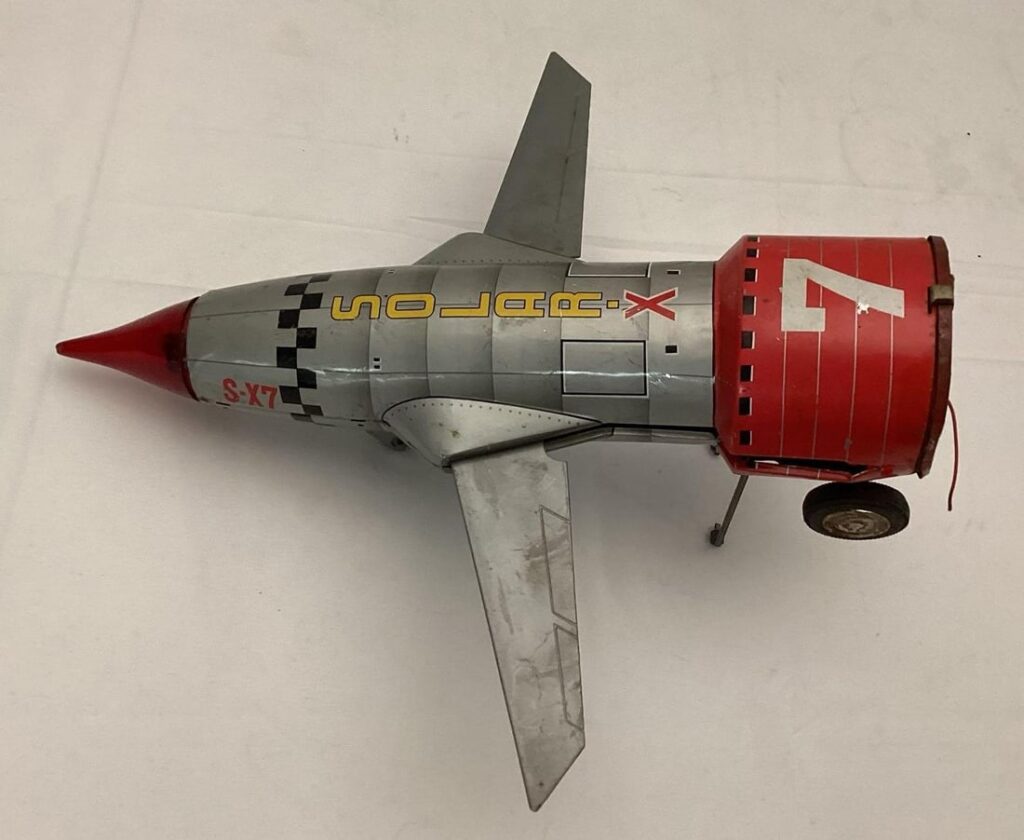
The Nomura Tin Litho Space Rocket, made by the Japanese company Nomura in the 1960s, is one of the most iconic space-themed toys of its time. Originally priced at only a few dollars, this toy now fetches anywhere from $1,500 to $4,000, depending on the rarity and condition. It features vibrant lithographed designs, space-age styling, and a wind-up mechanism that makes it appear as though the rocket is launching. The rocket was produced during the height of the space race, making it not just a toy, but also a historical artifact. Its colorful, futuristic design and the mechanical wind-up feature add to its enduring appeal among collectors.
What makes the Nomura Space Rocket so desirable is its connection to the 1960s space exploration excitement, combined with the high quality of Japanese tin toys. Many of these rockets were produced in large quantities, but few have survived in excellent condition due to wear and tear from play. The toy’s market value is significantly increased if it retains its original box and minimal signs of use. For collectors of space-themed toys and vintage Japanese tin pieces, this rocket is a must-have. Its high price at auctions is a testament to its lasting value in the world of collectible tin toys.
This article originally appeared on Avocadu.
